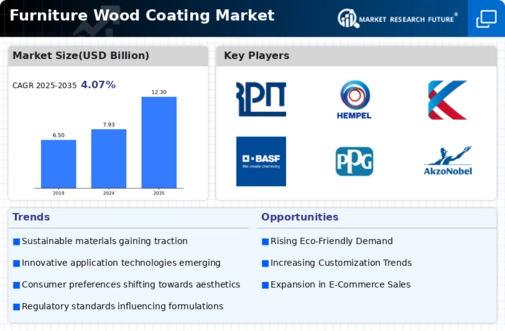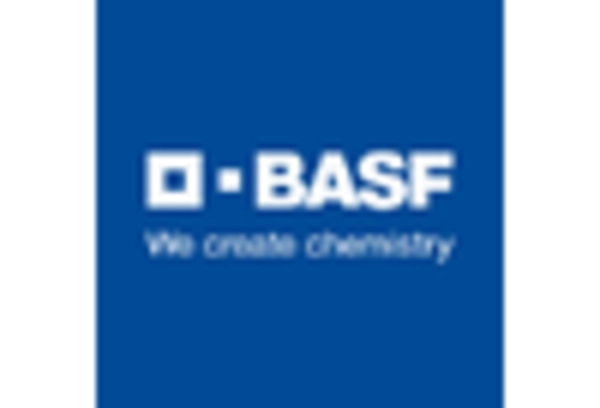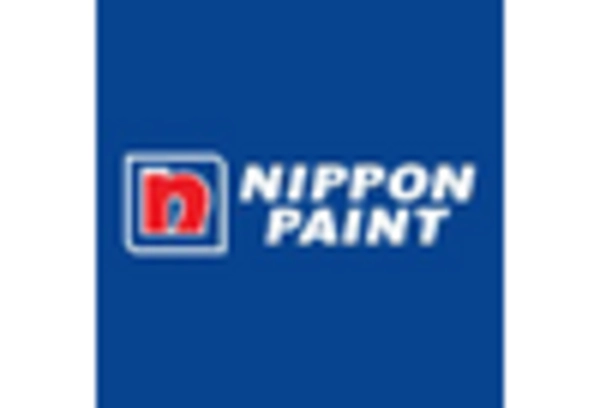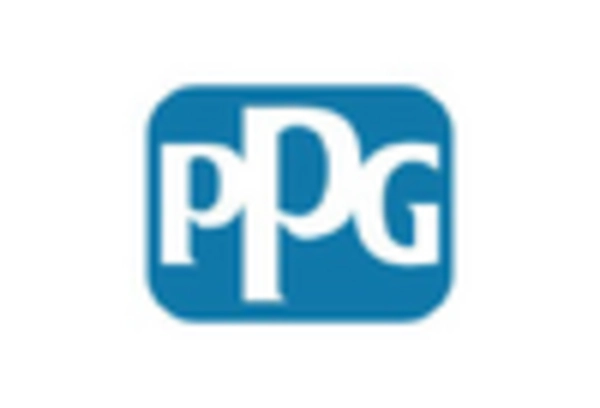Sustainability Focus
The Furniture Wood Coating Market is increasingly influenced by a growing emphasis on sustainability. Consumers are becoming more environmentally conscious, leading to a demand for eco-friendly coatings that minimize environmental impact. This trend is reflected in the rising popularity of water-based coatings, which are perceived as less harmful compared to traditional solvent-based options. In 2025, it is estimated that the market for sustainable wood coatings will account for a substantial portion of the overall industry, driven by regulations and consumer preferences. Manufacturers are responding by developing innovative products that utilize natural ingredients and sustainable practices, thereby enhancing their market position. This shift not only caters to consumer demand but also aligns with broader environmental goals, suggesting a long-term transformation within the Furniture Wood Coating Market.
Technological Advancements
Technological advancements are reshaping the Furniture Wood Coating Market, driving innovation and efficiency. The introduction of advanced application techniques, such as electrostatic spraying and UV curing, has revolutionized the way coatings are applied to wood surfaces. These technologies not only enhance the quality and durability of finishes but also reduce waste and improve production efficiency. In 2025, it is anticipated that the adoption of these technologies will continue to rise, as manufacturers seek to optimize their processes and meet increasing consumer demands for high-performance coatings. Furthermore, advancements in formulation chemistry are leading to the development of coatings with superior properties, such as enhanced scratch resistance and improved weatherability. This technological evolution is likely to play a crucial role in shaping the competitive landscape of the Furniture Wood Coating Market.
Growth of the Furniture Industry
The growth of the furniture industry serves as a fundamental driver for the Furniture Wood Coating Market. As the demand for furniture continues to rise, so does the need for high-quality wood coatings that enhance durability and appearance. In 2025, the furniture market is projected to expand significantly, driven by factors such as urbanization, rising disposable incomes, and changing consumer lifestyles. This growth is expected to create a corresponding increase in demand for wood coatings, as manufacturers seek to meet the evolving needs of consumers. Furthermore, the trend towards sustainable and eco-friendly furniture is likely to influence the types of coatings used, as manufacturers aim to align their products with consumer preferences. Consequently, the expansion of the furniture industry is poised to have a direct and positive impact on the Furniture Wood Coating Market.
Customization and Personalization
Customization and personalization are becoming pivotal drivers in the Furniture Wood Coating Market. As consumers seek unique and tailored solutions for their furniture, manufacturers are increasingly offering customizable coating options. This trend is particularly pronounced among high-end furniture brands, which are leveraging bespoke finishes to differentiate their products. In 2025, the market is projected to witness a significant increase in demand for personalized wood coatings, as consumers desire finishes that reflect their individual tastes and preferences. This shift towards customization not only enhances customer satisfaction but also fosters brand loyalty, as consumers are more likely to return to brands that offer personalized solutions. Consequently, companies that invest in innovative coating technologies and flexible production processes may gain a competitive edge in the Furniture Wood Coating Market.
Rising Demand for Aesthetic Appeal
The rising demand for aesthetic appeal in furniture is a significant driver in the Furniture Wood Coating Market. As consumers increasingly prioritize design and aesthetics, the choice of wood coatings has become a critical factor in furniture selection. Coatings that enhance the natural beauty of wood while providing protection are in high demand. In 2025, it is expected that the market for decorative wood coatings will experience substantial growth, as manufacturers introduce a wider range of colors, finishes, and textures. This trend is particularly evident in the residential sector, where homeowners seek to create visually appealing interiors. Additionally, the influence of social media and design trends is likely to further propel the demand for aesthetically pleasing wood coatings, prompting manufacturers to innovate and expand their product offerings within the Furniture Wood Coating Market.


















Leave a Comment